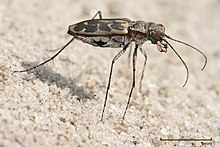Cicindela tranquebarica
The head consists of a hairy forehead, with erect setae, as well as a short upper lip and labrum with 3 teeth.
The C. tranquebarica is found distributed across most of the US, spanning from the Atlantic Coast to the western regions of the Sierra Nevada and Cascades.
Examples of possible habitats for the tiger beetle are "banks and mud falts of creeks and rivers, dry lake beds, tidal flats, roadside ditches, packed grabelly-sandy roads near water, open ground, old fields, stubble fields, saline and alkali flats, blowouts, sand pits, in prairie grasslands forest trails, and roads".
[7] Specifically, the beetles in Montana have been reported to live in habitats such as "sedge-grass sand flats, hard-packed gravelly-sandy roads near water, along creeks and ditches, saline/alkali flats, riparian dunes, sandy blowouts, sand pits, river sandbars, and old river crossings.
"[7] In a study performed to examine differences between 2 species of Cicindela beetles, the daily movements of C. tranquebarica was researched in Northeast Arizona.
[8] The purpose of this study was to inspect the difference in physiological limitations between 2 species of the same family, and it tracked the locations of beetles across a beach with varying microclimates.
It was seen from the experiment that the C. tranquebarica tended to remain on the "dry, upper portions of the beach" while shuttling between sun and shade.
[8] This phenomenon is related to the high wax density and larger amount of saturated hydrocarbons on the cuticle surface of the oblique-lined tiger beetle.
Further observations showed that C. tranquebarica appears to frequently reside in the shade, and this could be due to a narrow optimal temperature range.
[8] Due to a steep thermal gradient present on the beach, the area in which temperature is optimal for C. tranquebarica is relatively small, and requires frequent shuttling.
A unique aspect of the C. tranquebarica is their compound eyes, which were examined in a study using techniques such as scanning, light, and transmission electron microscopy.
A notable feature among ectothermic beetles within the family Cicindelidae is the unique ability to control body temperature.
This mechanism is widely appreciated and studied, although little information is known about how the control of body temperature affects field activity of these beetles.
Although not much information is known on the status of oblique-lined tiger beetles, the species is not considered rare,[7] and there is no need for special conservation management.
While colonies can be negatively impacted by livestock overgrazing, the act of grazing also can also help beetles by keeping vegetation cover more open.
